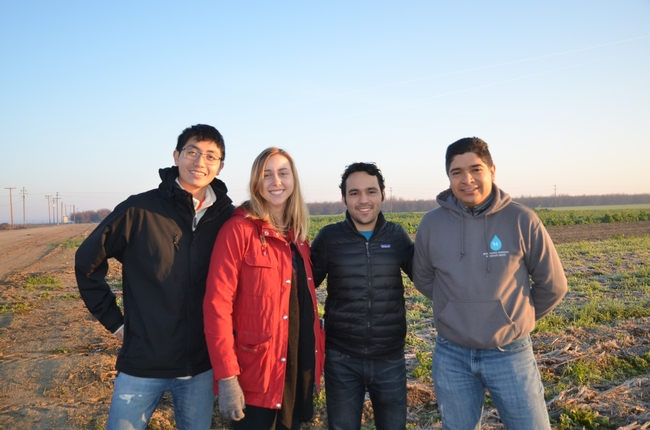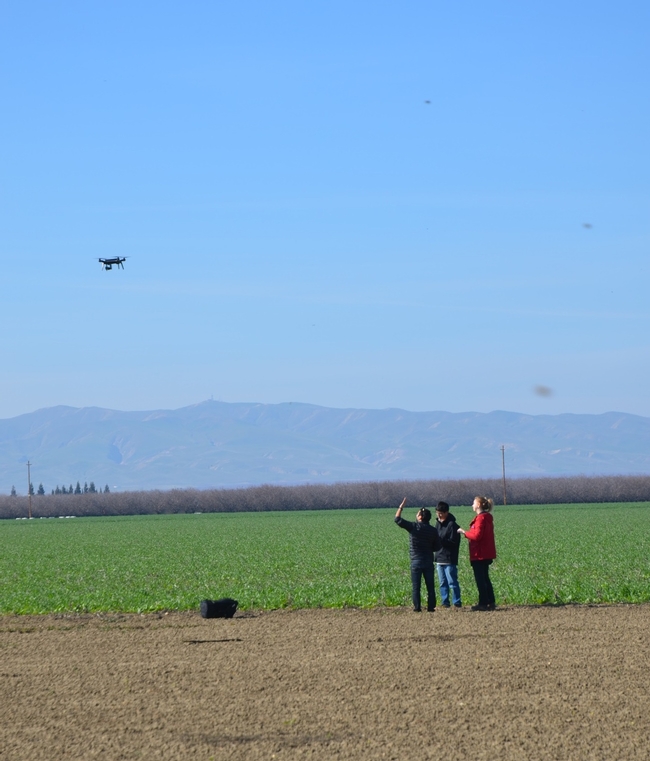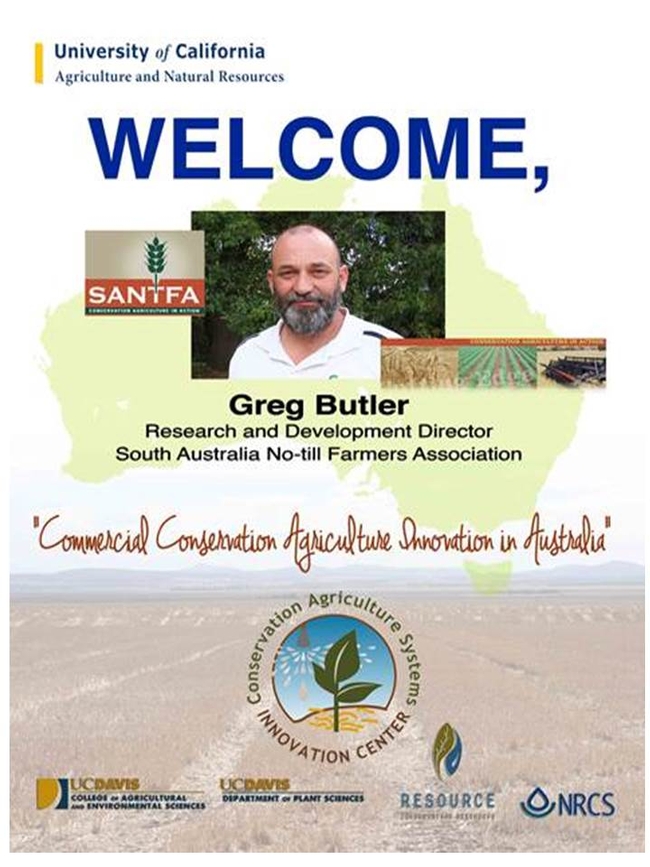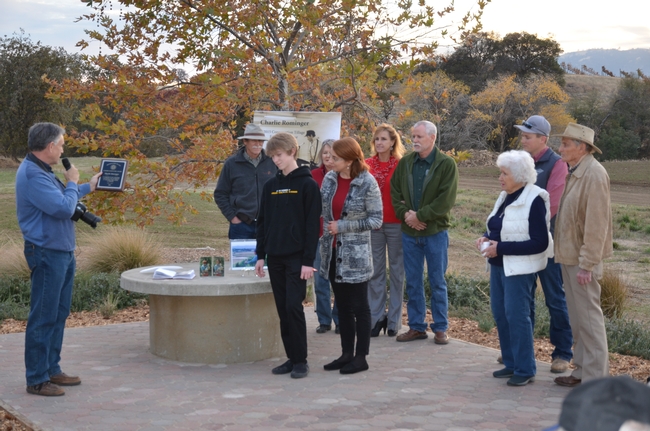Conservation agriculture news
UC Davis Hydrology Team Visits NRI Study Field in Five Points and Four Cover Crop San Joaquin Valley Farms
The group visited cover crop evaluation sites at the Five Points farm of Scott Schmidt, the Firebaugh farm of Alan Sano and Jesse Sanchez, the Madera farm of Kirk Texeira and Lucero Farms, and the pistachio orchard of Jacob Sheely near Lemoore. Alyssa and Samuel are part of a team that also includes UCD Hydrologist, Daniele Zaccaria, UC Merced Climate Change scientist, Tapan Pathak, UCCE Advisors Dan Munk, Gene Miyao, and Roger Duncan, and Jeff Mitchell, of UCD's Department of Plant Sciences. This team is conducting work to evaluate tradeoffs of winter cover crops with respect to soil water depletions, costs, carbon capture and soil improvement in a range of orchard and tomato production systems. A variety of data collection efforts are now underway including the use of soil water content sensors and dataloggers, neutron probe soil water content determinations, and commercial field ET measurement instrumentation that is also being installed at the study sites. The project began in the fall of 2015 and hopes to expand to additional sites that will be intensively monitored during the coming two years. Additional information on the preliminary findings for the 2015 – 2016 winter period will be available soon.
CASI Hosts Greg Butler of the South Australian No-till Farmers Association
About thirty CASI members were treated to a fascinating discussion of some of the very innovative work that Greg Butler, Research and Development Director of the South Australian No-till Farmers Association, and the more than 500 Australian farmers who make up SANTFA are doing to be proactive and to create “real innovation in real time.” SANTFA is a non-profit farmer-driven organization that develops and shares information on high quality no-till systems and creates a wide variety of quite impressive technological advances in the “broad-acre,” or field crop farming systems that are common throughout the state of South Australia. A key aspect of SANTFA is the close relations the organization has with private sector partners and their true emphasis on improved, practical and profitable production systems. Accompanying Greg at the seminar that took place on the UC Davis campus on Friday, January 22, were Dylan Howes of FLOW, an ultra-high pressure water jet technology company, and Neil Wahlgren, of CoolPlanet, a biocarbon production company.
Butler presented recent work that he and SANTFA partners are conducting using ultra-high pressure water jet technology to cut residues as part of overall residue management systems, and also on precision application of engineered biochar. Because over 85 or so percent of farmers in this region of Australia already use no-tillage seeding techniques, the emphasis of SANTFA is now looking to address specific problems that their conservation agriculture practices have with truly integrated residue, fertilizer, weed, and water management systems.
A video of Greg's presentation is available at the CASI website at https://videocenter.plantsciences.ucdavis.edu/videos/video/185/.
CASI takes part in planning meeting in AZ
Several CASI members recently took part in a planning workshop that was held at the University of Arizona's Maricopa Agricultural Center to consider and develop opportunities for working together on joint research aimed at coupling advanced technologies and practices for high efficiency and resource-conserving vegetable production systems for California, Arizona, and New Mexico. 28 people took part in the meeting that included farmers, university and NRCS participants from these three states along with a colleague from Iowa State University. The meeting occurred as a follow-up to a similar sort of regional planning session that was held in Salt Lake City, UT in 2014 that brought together farmer, NRCS and land-grant university representatives from 18 of the western states in the US to share information related to high residue, conservation agriculture production systems. The goals of the meeting in AZ were to develop ideas and a joint research proposal aimed at maintaining the competitiveness of vegetable farms in these three states while simultaneously developing practices that address uncertainties of climate change, energy costs, and labor and water shortages. The practices that were discussed are designed to increase production system efficiency while also providing opportunities for testing alternatives that have not yet been applied to the production challenges of high-value vegetable production systems such as the use of a variety of conservation agriculture practices and principles that have been successfully been used in several regions of the world for various agronomic crops.
To view a short clip of some of the people attending this important planning meeting click the link below.
Planning Meeting in Arizona
2015 CT Farmer Innovator recognition posthomously awarded to Charlie Rominger
In 2005, the University of California and NRCS Conservation Tillage Workgroup established the Conservation Tillage Farmer Innovator Award as a means for providing greater visibility to CT pioneers in California. The criteria for this award are – demonstrated innovation and leadership in the development, refinement and use of conservation tillage systems within the California crop production environment. Nominations are received and carefully reviewed by a Workgroup panel and recipients are announced in a fitting annual recognition meeting.
On Wednesday, December 2nd, this year's CT Farmer Innovator recognition was posthumously awarded to Charlie Rominger in a very moving and memorable ceremony that took place at the home of Charlie's brother, Bruce Rominger and his wife, Robyn, just north of Winters, CA. About ten members of the Rominger family and over forty others who had known Charlie were in attendance.
This year's award recognizes a truly exceptional CT pioneer. In a number of very significant ways, Charlie Rominger epitomized the intent of this prestigious CT Workgroup award and our recognition of him today, greatly enhances our tradition of acknowledging truly outstanding innovation and achievement.
Excerpts of the nomination document that was submitted on behalf of Charlie and that was prepared by his very good and long-term colleague and friend, Phil Hogan, the District Conservationist here in Yolo County with the USDA's Natural Resources Conservation Service, along with the help and encouragement of Lorry Dunning, a retired agricultural historian and consultant who worked in the College of Biological and Agricultural Engineering at the University of California, Davis are briefly provided here.
The story of Charlie Rominger and his unique and great contributions to the development of conservation tillage systems in California begins in 1984, when the Yolo County Resource Conservation District (RCD) recognized that the landform known as the Dunnigan Hills and other low-lying hills in Yolo County were subject to massive sheet and rill erosion. This erosion was the result of the way that the hills were farmed at the time – conventional tillage using a moldboard plow left little to no crop residues to protect the soil from the impact of raindrops.
The Soil Conservation Service, or SCS staff in the early 1980's used the Universal Soil Loss Equation (USLE) to determine that about 40,000 acres in Yolo County had a significant erosion risk. The majority of dry-farmed areas over 10-15% slope were determined to be eroding at excessive rates. The RCD, through its Long Range Plan, recommended that most of this cropland needed to be returned to permanent cover, or that some kind of conservation tillage be used to reduce erosion to tolerable limits.
Once this problem had been identified, the SCS in Yolo County had two growers who would become conservation tillage pioneers. These were Charlie Rominger, and his friend, Fritz Durst.
In the mid-1980's, the Agricultural Stabilization and Conservation Service started cost-sharing on conservation tillage. A grower, if he or she signed up, could receive up to $3,500 to switch from conventional tillage to conservation tillage. The practice proved to be not that popular, but Charlie Rominger was one of the young growers who stepped up to the plate and applied for the practice. As with Fritz Durst, Charlie saw early success with the practice as well as some initial problems, and in those early days, he was regularly featured in the local media and statewide farming publications.
Another major factor that led to producers adopting conservation tillage during these very early days that came about in the 1985-86 period was the 1985 Farm Bill, or the Food Security Act. This act mandated that if growers were going to farm Highly Erodible Land (HEL), they would have to do so according to what was called a conservation compliance plan. This plan stipulated that they had to farm in a way that reduced soil erosion levels down to a certain level. About 40,000 acres of local land had these conservation compliance plans on them, and there has been very little non-compliance with the plans since. Another alternative that growers had was to enroll their HEL into the Conservation Reserve Program (CRP) which would set aside the land from cropping. Charlie realized that some of his land was so fragile, that no matter whether he used no-till or not, the soil would still erode above tolerable levels. It was this most fragile land that he into the CRP program. The CRP places the HEL under permanent vegetative cover for the duration of a 10-year contract. Many growers again followed Charlie's leadership and also enrolled their land into the CRP.
Charlie's first attempt with no-till was in 1985 and it was a success, - using a Palouse grain drill, he produced a 2,746 lb per acre wheat yield with his no-till compared to just over 3,000 lbs per acre for his conventional fields. This made a small profit and had a better net profit than all but one of his conventional fields.
During these early efforts, Charlie also experimented with the Haybuster drill as well as with different fertilizers and herbicide systems. He would take advantage of an early germinating rain and would use RoundUp just after he planted his wheat, but before it emerged.
These efforts with no-till were some of the earliest and most pioneering trials in California and Charlie was always more than happy to share his experiences with no-till with other farmers. In February of 1985, Charlie gave a presentation on his experiences with no-till at the first-ever conservation tillage workshop held in Zamora. Then, in April of 1988, Charlie, Fritz Durst, and Phil Hogan climbed into a small SCS car at 2 a.m., and drove 5 hours down to Paso Robles for the 8th Annual Conservation Tillage Workshop sponsored by the UC Cooperative Extension Service. There, Charlie was one of the speakers.
During these very early days, Charlie was also a great partner for UC Cooperative Extension research and extension education scientists, Stu Pettygrove, Tom Kearney, and Karen Klonsky. Data from several years of Charlie's early no-till efforts were published by Stu Pettygrove in 1995 in the publication, No-till wheat and barley production in California.
Charlie was always very appreciative of the technical assistance that he received from Stu, Tom and Karen, and they in turn, were extremely grateful of the wonderful partnership they shared with him.
Likewise, Charlie's NRCS partners were also very grateful to him for his pioneering work.
The Residue Management Guide that was produced by the Woodland and Dixon field offices of NRCS in the early 1990s was essentially documenting the great work that Charlie Rominger and Fritz Durst had done on their farms with no-till.
Over the years, attention given to what was happening during those early days with no-till in the hills of western Yolo County has waned. Thousands of acres of land were enrolled in the Conservation Reserve Program, and low grain prices left much of the rest idle. In addition, much of the Highly Erodible Land in Yolo County has been, and continues to be, converted to almond and olive orchards, vineyards, and rangeland. In his historical nomination of the pioneering accomplishments of Charlie, Phil Hogan wonders what Charlie would have thought of the sustainability of these new land uses for this once dry land. It is likely that he would have been very concerned about the impacts on groundwater supplies and degradation of wildlife habitat.
Charlie played a major role in promoting the use of no-till in the dry hills of Yolo County. The knowledge that he was so instrumental in helping to develop continues to yield benefits today. With the current extended drought and the snowpack in the Sierras that has been much lower than average, surface water for irrigation will likely be increasingly curtailed. Farmers are going to have to rely on the ability to store more available moisture in the soil by increasing organic matter. Properly managed soils, as Charlie pioneered, will be the water reservoirs of the future.
Long before today, with our Workgroup's recognition of Charlie Rominger, he was widely recognized for his leadership with no-till.
In 1986, he received the Yolo County Resource Conservation District's Cooperator of the Year Award.
In 1987, Charlie received The National Endowment for Soil and Water Conservation award for outstanding achievement in conserving soil and water resources.
And in 1987, Charlie was also recognized by then Governor of California, George Deukmejian.
Charlie's greatest reward, however, was when he was roaming the hills of his farm north of Winters. He took a holistic view of conservation; - Yes, using no-till to reduce soil erosion was one of his primary motivators, but, so was improving soil health, increasing wildlife habitat, and improving water quality.
In the Winter 2005 UC Davis Magazine, Charlie was quoted as saying, “The more we get our business processes to mimic nature, the more benefits we find. Carbon sequestration is one of the bonus synergies we get by doing things in harmony, rather than in conflict, with natural process.”
His hero, Aldo Leopold, could not have said it better.
If you travel out to these hills, you can readily see Charlie's legacy on the land. The ponds and wetlands he created continue to provide vital habitat for wildlife. The many miles of hedgerows along the county roads are still there. In his nomination of Charlie Rominger for today's recognition, Phil Hogan says that he can still see Charlie in his memories of him, walking the fields, wearing that signature pith helmet. Despite all that he accomplished, he always felt that there was much more to be done.
Charlie Rominger made simply huge contributions to the development of knowledge and to the expansion of CT systems in the California. The quality of his innovations was unmatched and he was ever willing to graciously share his knowledge with others. He personified the intent of our CT Farmer Innovator Award. Our recognition of Charlie Rominger today reminds us all of the great honor we had in knowing him.
Prepared by Phil Hogan, USDA NRCS Yolo County (phil.hogan@ca.usda.gov), Lorry Dunning, Retired Historian and Consultant (histcon@gmail.com), and Jeff Mitchell, UC Davis Plant Sciences Department (jpmitchell@ucdavis.edu).
The Green Blog
Calling your attention to the ANR Green Blog //ucanr.edu/blogs/Green/
There are lots of interesting things there.




